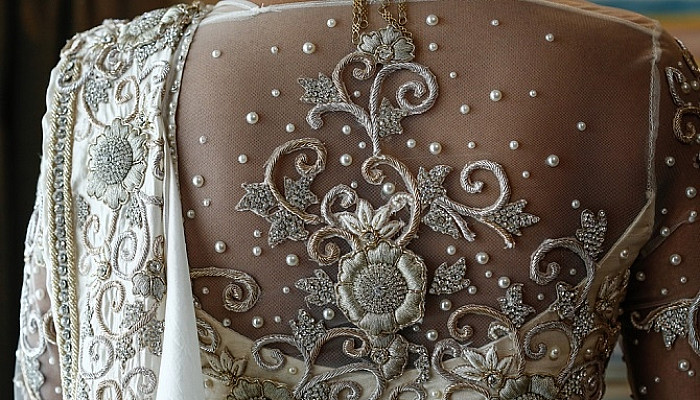
Ethnic Wedding Attire

Understanding Ethnic Origin
Ethnic identity is marked by the recognition from others of a group's distinctiveness and by common cultural, linguistic, religious, behavioral or biological traits. An ethnic group is a group of human beings whose members identify with each other, usually on the basis of preferential practice of marrying within a social group and/or a presumed or real common ancestry.
Ethnicity in specific countries
In the United States of America, collectives of related ethnic groups are typically denoted as "ethnic." Most prominently in the United States, the various Latin American racial and ancestral groups are typically grouped as either "Hispanics" or "Latinos". The many previously designated 'Oriental' ethnic groups are designated as Asian ethnic groups and similarly linked together as "Asians." The terms "Black" and "African-American," while different, usually describe the descendants whose ancestors were indigenous to Africa and generally excludes the African descendants of European colonists.
Even the racial term "White American" generally describes people whose ancestry can be traced to Europe (including non-European nations such as Argentina, Australia, and Canada where European ancestry contributes to the overall populations) who now live in the United States. "Middle Easterners" are peoples from the Middle-East, i.e. Southwest Asia and North Africa. These countries include Iran, Tunisia, Iraq, Saudi Arabia, Egypt, Libya, Algeria, and Morocco. (The United States Census Bureau compiled a list of ethnic groups which may be seen at Ethnicity (United States Census)).
In the United Kingdom, different classifications, both formal and informal, are used. Perhaps the most accepted is the National Statistics classification, identical to that used in the 2001 Census in England and Wales. In general popular use in the United Kingdom and Europe, the terms oriental and Asian are widespread and without negative connotation, with the latter term usually reserved in the United Kingdom for people from the Indian subcontinent.
China officially recognizes 56 ethnic groups of which the majority is comprised by the Han Chinese. Many of the ethnic minorities maintain their own individual culture and language, although many are also becoming more like the Han Chinese. Han Chinese predominates most areas of China with the exception of Tibet and Xinjiang where the Han are still in the minority. The Han Chinese are the only ethnic group bound by the One-child policy.
In France, no population census includes ethnic categories, and the government is prohibited from collecting, maintaining or using ethnic population statistics. The current French government, led by Nicolas Sarkozy and François Fillon, has begun a legislative process to repeal this prohibition.
Ethnic Wedding Attire
In many regions of the world, national costumes and styles in clothing and ornament declare membership in a certain village, caste, religion, etc. A Scotsman declares his clan with his tartan. A French peasant woman identified her village with her cap or coif.
Clothes can also proclaim dissent from cultural norms and mainstream beliefs, as well as personal independence. In 19th-century Europe, artists and writers lived la vie de Bohème and dressed to shock: George Sand in men's clothing, female emancipationists in bloomers, male artists in velvet waistcoats and gaudy neckcloths. Bohemians, beatniks, hippies, Goths, Punks and Skinheads have continued the (countercultural) tradition in the 20th-century West. Now that haute couture plagiarizes street fashion within a year or so, street fashion may have lost some of its power to shock, but it still motivates millions trying to look hip and cool.
Traditionally, Hindu women wear sindoor, a red powder, in the parting of their hair to indicate their married status; if widowed, they abandon sindoor and jewelry and wear simple white clothing. However this is not true of all Hindu women; in the modern world this is not a norm and women without sindoor may not necessarily be unmarried.
Clothing is an aspect of human physical appearance, and like other aspects of human physical appearance it has social significance. All societies have dress codes, most of which are unwritten but understood by most members of the society. The dress code has built in rules or signals indicating the message being given by a person's clothing and how it is worn. This message may include indications of the person's social class, income, occupation, ethnic and religious affiliation, attitude, marital status, sexual availability and sexual orientation.
Clothes convey other social messages including the stating or claiming personal or cultural identity, the establishing, maintaining, or defying social group norms, and appreciating comfort and functionality.
If the receiver's code of interpretation differs from the sender's code of communication, misinterpretation follows. In every culture, current fashion governs the manner of consciously constructing, assembling, and wearing clothing to convey a social message. The rate of change of fashion varies, and so modifies the style in wearing clothes and its accessories within months or days, especially in small social groups or in communications media-influenced modern societies. More extensive changes, requiring more time, money, and effort to effect, may span generations. When fashion changes, the messages communicated by clothing change.
Different wedding traditions call for different wedding attire:
- Qipao, Chinese traditional formal wear
- Batik and Kebaya, a special garment worn by the Japanese people of Indonesia .
- Barong Tagalog, an embroidered formal garment of the Philippines
- Kimono, the traditional garments of Japan
- Ao dai, traditional garments of Vietnam
- Morning dress, a particular category of men’s formal dress
- Topor, a type of conical headgear traditionally worn by grooms as part of the Bengali Hindu wedding ceremony
- Sherwani , a long coat-like garment worn in South Asia
- Tuxedos
- Black tie, indicating dinner jacket in the United States and United Kingdom
- White tie, indicating evening dress in the United States and United Kingdom
This content was created by AI





















